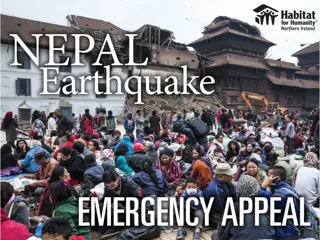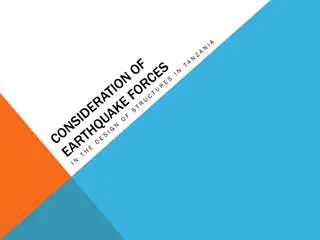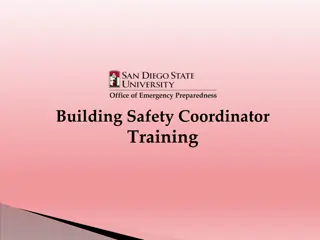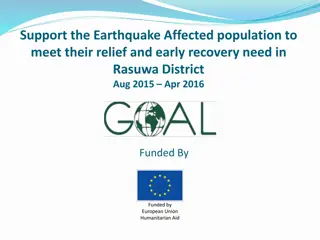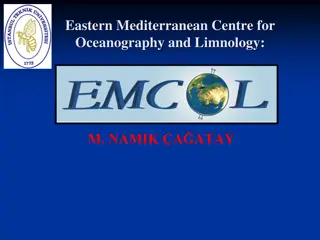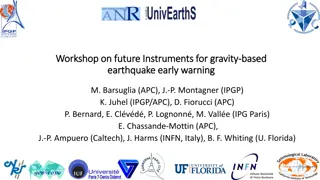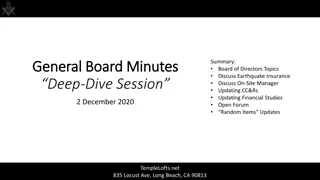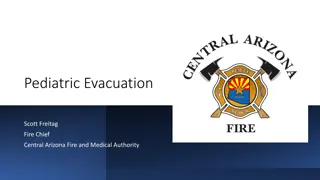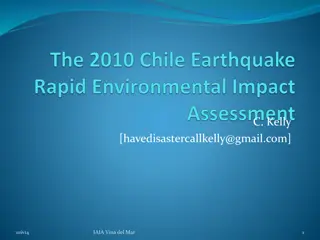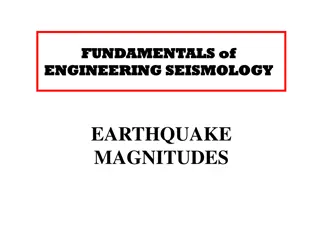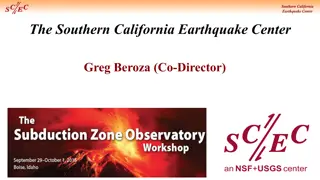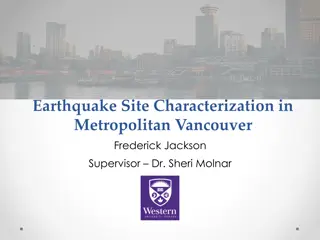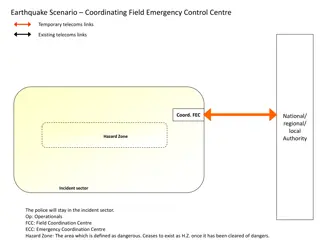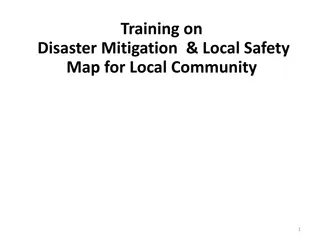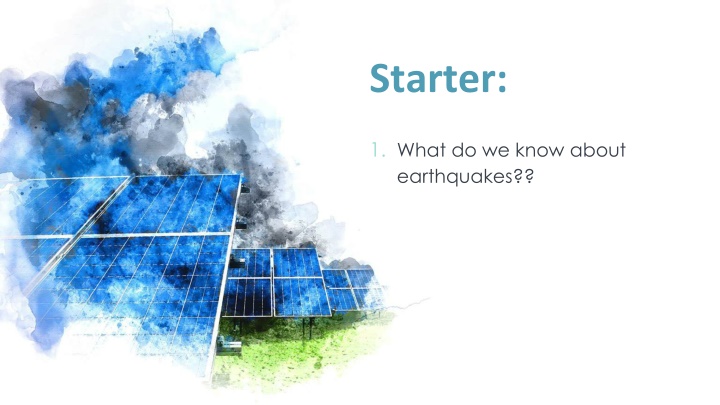
Fascinating Earthquake Insights
Earthquakes are natural occurrences caused by the release of energy within the Earth's lithosphere. The rapid slippage along faults generates seismic waves that can lead to destructive tremors. The San Andreas fault in California is a notable example, demonstrating different behaviors across its length and historic seismic events like the 1906 San Francisco Earthquake.
Download Presentation

Please find below an Image/Link to download the presentation.
The content on the website is provided AS IS for your information and personal use only. It may not be sold, licensed, or shared on other websites without obtaining consent from the author. If you encounter any issues during the download, it is possible that the publisher has removed the file from their server.
You are allowed to download the files provided on this website for personal or commercial use, subject to the condition that they are used lawfully. All files are the property of their respective owners.
The content on the website is provided AS IS for your information and personal use only. It may not be sold, licensed, or shared on other websites without obtaining consent from the author.
E N D
Presentation Transcript
Starter: 1. What do we know about earthquakes??
The Physical Environment Lesson 5. Earthquakes
Lesson 5. Earthquakes Learning Goals: 1. Describe how earthquakes are caused. 2. Explain how earthquakes are measured. 3. Explain the differences between body waves and surface waves.
Earthquakes Each year more than 30,000 earthquakes happen worldwide. Most are minor and do very little damage. Only about 100 major earthquakes happen each year on the average. If one of these major earthquakes happens near a city or heavily populated area, the results can be very destructive
An earthquake is the vibration of Earth produced by the rapid release of energy within the lithosphere. Earthquakes are produced by slippage along a break in the lithosphere called a fault. The point within the earth where the earthquake starts is called the focus. The focus of an earthquake is located along a fault underneath the surface. The point on land where the earthquake does the most damage is directly above the focus. This point is called the epicentre. The energy released by the earthquake travels in all directions from the focus in the form of seismic waves.
The San Andreas fault: The San Andreas fault in California is one of the most studied fault systems in the world. This fault extends about 1300 kilometers through the state and into the Pacific ocean. Studies have shown that displacement has occurred along the fault in areas as much as 200 kilometers long.
The San Andreas fault: The San Andreas fault is 1300 kilometers long but segments of it 100 to 200 kilometers long tend to act individually. Some segments show a slow, gradual slip known as fault creep. Other sections regularly slip and produce small earthquakes. Some segments remain unmoved for hundreds of years and then move suddenly with explosive force producing large earthquakes.
The San Andreas fault: One great earthquake along the fault was the San Francisco Earthquake of 1906. During this earthquake, the land on the western side of the fault moved 4.7 meters in relation to the land on the east.
Before the San Francisco Earthquake, scientists did not understand what caused them. Studies afterward led to the development of a hypothesis that explained earthquakes. According to the elastic rebound theory, most earthquakes are produced by the rapid release of energy stored in rock that has been subjected to great forces. When the strength of the rock is exceeded, it suddenly breaks, releasing some of it s energy as seismic waves.
In 2003, a powerful earthquake shook Alaska wilderness south of Fairbanks along the Denali front. This earthquake was so strong it shook ponds in Louisiana and Texas. Seismic waves carry the energy released from an earthquake hundreds of kilometers away. Seismic waves transmit the energy of these vibrations from particle to particle. Like a bell hit with a hammer, the vibrations ring through the rocks the bedrock that makes up the lithosphere.
Earthquakes produce two main types of seismic waves Body waves Surface waves These seismic waves differ in their type of wave motion, their behavior as they travel through the Earth, and their speed. The waves that travel through the Earth s interior are called body waves. There are two types of body waves P waves S waves
Body Waves: P waves are push-pull waves that push and pull particles as they move in a direction. They could also be said to compress-expand. P waves are also called compressional waves. P waves travel faster than S waves. P waves can travel through both liquids and solids. S waves shake particles at right angles to the waves direction. Like taking one end of a rope and shaking it, the waves move in a curve. S waves are also called transverse waves.
Surface waves: When body waves reach the surface, they produce surface waves. Surface waves travel more slowly than body waves do. Surface waves move up and down as well as side-to-side. Surface waves are usually much larger than body waves, so surface waves are usually the most destructive seismic waves. 1. Love waves 2. Rayleigh Waves
Love Waves: A Love wave is a surface wave having a horizontal motion that is transverse (or perpendicular) to the direction the wave is traveling. Rayleigh Waves: A Rayleigh wave is a seismic surface wave causing the ground to shake in an elliptical motion, with no transverse, or perpendicular, motion.
Recording Seismic Waves: Scientists have developed an instrument to record seismic waves: the seismograph. A seismograph produces a time record of the ground motion during an earthquake. How it works: A seismograph has a weight suspended from a support that is attached to the bedrock. When seismic waves reach the bedrock, the inertia of the suspended weight keeps the weight arm almost stationary while the bedrock moves. In older seismographs, a pen suspended drew on a rotating cylinder and the traces showed the movement of the waves.
Seismogram: The time record that a seismograph produces is called a seismogram. A seismogram shows all three types of seismic waves. The stronger the earthquake, the larger the waves on the seismogram. The first wave to arrive is the P wave, followed soon after by the S wave. After the S waves, the Surface waves arrive showing much stronger movement.
Intensity is a measure of the amount of earth shaking that happens at a given location in an earthquake. Magnitude (M) is a measure of the size of the seismic waves or the amount of energy released at the source of the earthquake. The Richter Scale measures earthquake s magnitude. The Modified Mercalli Scale is based on earthquake intensity.
Richter Scale: A familiar but outdated scale for measuring the magnitude of earthquakes is the Richter Scale. The Richter Scale is based on the height of the largest seismic wave (P,S, or surface wave) recorded on a seismograph. A 10X increase in wave height equals an increase of 1 on the Richter Scale. An increase for a M5.0 earthquake is 10 times greater than the shaking produced by a magnitude 4.0 on the Richter Scale.
Modified Mercalli Scale: Another scale used to rate earthquakes is the modified Mercalli scale. This scale rates an earthquake s intensity in terms of an earthquake s effects at different locations (how much shaking it creates or damage it does). The scale has 12 steps expressed as Roman numerals An earthquake that is barely felt rates a I. An earthquake which creates almost total destruction rates a XII The same earthquake can rate different Mercalli scale ratings at different locations.
Review: 1. Key terms dominoes!! 2. Key terms bingo!!
Focus: the point beneath Earth's surface where rock that is under stress breaks Review: Earthquak e Vocabular y Epicenter: point directly above the focus on the earths surface Seismic waves: vibrations that travel through Earth's surface carrying energy Primary waves: the earthquake waves that compress and expand the ground like an accordion Secondary waves: the waves that vibrate from side to side as well as up and down Surface waves: when Primary waves and Secondary waves reach the surface some of them are transformed into Surface waves Seismograph: instrument that geologist use to record and measure the vibration of seismic wave Magnitude: the measurement of earthquake strength based on seismic waves Mercalli Scale: rate earthquakes by their intensity Richter Scale: rate earthquakes by mechanical seismograph Moment Magnitude Scale: rates earthquakes by estimating the total energy released

